Family : Heliconiaceae

Text © Pietro Puccio

English translation by Mario Beltramini
Heliconia chartacea is native to tropical South America where can be 7-8 m tall © Giuseppe Mazza
The species is native to Brazil (Acre, Amazonas, Amapá, Pará, Roraima, Rondônia and Tocantins), Ecuador, French Guyana, Guyana, Peru, Surinam and Venezuela, where it lives in the humid forests.
The genus name comes from the Latin “Heliconius, a, um” = of the Helicon, mountain sacred to Apollo and to the Muses in the Greek mythology; the species name is the Latin adjective “chartaceous, a, um” = chartaceous.
Common names: pink flamingo heliconia (English); caetê-bravo (Portuguese-Brazil).
The Heliconia chartacea Lane ex Barreiros (1972) is an evergreen, perennial, rhizomatous, erect herbaceous species forming up to 7-8 m tall dense tufts, but which, in cultivation, keep lower.
The leaves, on 0,3-1 m long petiole covered by a whitish waxy patina, are basal, alternate, simple, entire, oblong, up to 3 m long and 40 cm broad, with the sheathing tubular foliar bases forming a pseudo-stem; the foliar lamina is subdivided perpendicularly to the rachis in numerous sections having different breadth.
The inflorescence, on a robust peduncle, is a drooping terminal spike, up to about 1,5 m long, with wavy intense pink to red rachis, tomentose, and up to 28 bracts with pointed apex and concavity looking downwards, spirally arranged, alternate, coriaceous, waxy, the basal ones 20-28 cm long, pinkish to red with white greenish margin, enclosing several yellow greenish tubular flowers opening in succession.
The flowers, with bilateral symmetry, are hermaphroditic, with 3 sepals, two of which merged and one free, and three merged petals, little differentiated among them, 5 fertile stamina and one staminode opposite to the free sepal; the flowers are pollinated by the hummingbirds.
The fruits are globose drupes, dark blue when ripe, of about 1 cm of diameter, containing 1-3 seeds.
It reproduces by seeds, previously kept in water for 2 days to soften the tegument, in organic loam with addition of siliceous sand or agri-perlite for a 30%, kept humid at the temperature of 26-28 °C, with germination times varying up to 12 months, but usually and easily by division of the rhizomes.
Species among the most ornamental of the genus with drooping inflorescence, of which they have selected numerous varieties, among which the most famous and diffused are the ‘Sexy Pink’ and the ‘Sexy Scarlet’, cultivable in the humid tropical climate regions, and only marginally in the subtropical ones, in full sun or in partial shade on soils rich of organic substance, draining, kept constantly humid but without stagnations.

Drooping inflorescences may exceed 150 cm, with 20-28 cm 28 bracts. Several varieties like ‘Sexy Pink’, left and ‘Meeana’, right © Giuseppe Mazza
Where the climate does not allow the permanence in open air during the winter months, it can be cultivated in capacious pots for being sheltered in greenhouses, verandas or luminous winter gardens, using an organic substratum with addition of siliceous sand or agri-perlite for a 30% to improve the drainage, with ambient humidity and high diurnal temperatures and lowest night ones not under the 16 °C. The watering must be regular and abundant in summer, allowing the substratum to dry up partially before giving water again, avoiding stagnations, cause of easy rottenness, more spaced in winter, but without allowing the substratum to dry up completely, and the fertilizations preferably done with slow release balanced products with addition of microelements.
It is easily subject to attacks of mites and of mealy bugs, to be treated in case of serious infestation with specific products. The long-lasting, up to 2 weeks, cut inflorescences, are utilized in the floral compositions.
